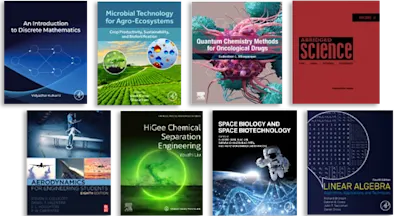
Vaccine Biotechnology
Advances in Veterinary Science and Comparative Medicine, Vol. 33
- 1st Edition - January 1, 1989
- Latest edition
- Editors: James L. Bittle, Frederick A. Murphy
- Language: English
- Paperback ISBN:9 7 8 - 1 - 4 8 3 2 - 0 2 3 8 - 9
- eBook ISBN:9 7 8 - 1 - 4 8 3 2 - 1 5 8 1 - 5
Advances in Veterinary Science and Comparative Medicine, Volume 33: Vaccine Biotechnology presents advances in the field of vaccinology and approaches in the development of… Read more

Advances in Veterinary Science and Comparative Medicine, Volume 33: Vaccine Biotechnology presents advances in the field of vaccinology and approaches in the development of vaccines. This book discusses the developments in vaccinology in a comparative way, examining the successes and failures in human and veterinary medicine for the overall benefit of infectious disease control. The diverse technologies contributing to the improvement of vaccines are also covered, including the role of structural analysis, molecular anatomy, nature of antigenic epitopes, and surfaces of infectious organisms. This publication likewise considers the improvements in safety, efficacy, stability, simplicity of production, and cost in the applications of recombinant-DNA technology, which would mean wider availability and use of vaccines in the future. This volume is valuable to medical, biomedical, and veterinary scientists.
Preface
Vaccines Produced by Conventional Means to Control Major Infectious Diseases of Man and Animals
I. Vaccines for DNA Viruses
II. Vaccines for RNA Viruses
III. Vaccines for Gram-Positive Bacteria
IV. Vaccines for Gram-Negative Bacteria
References
Poliovirus: Three-Dimensional Structure of a Viral Antigen
I. Introduction
II. Poliovirus
III. Poliovirus Structure
IV. Antigenic Sites
V. Use of Synthetic Peptides to Characterize Antigenic Sites
VI. Comparison of Antigenic Structures of Polio and Rhinovirus
VII. Relationship between Antigenic Sites and Possible Receptor Binding Sites
VIII. Future Prospects
References
Immune Response to Vaccination
I. Introduction
II. Lymphoid System
III. Infection and Immunity
IV. Summary
References
The Development of Biosynthetic Vaccines
I. Introduction
II. Biosynthesis of Subunit Immunogens
III. Progress toward the Generation of Useful Vaccines
IV. Considerations in the Design of Biosynthetic Subunit Vaccines
References
The Development of Chemically Synthesized Vaccines
I. Introduction
II. The Concept of Synthetic Vaccines
III. Requirements for a Protective Immune Response
IV. The Problem of Antigenic Variation
V. The Potential of Peptide Vaccines for Other Diseases
VI. What Does the Future Hold?
References
Infectious Recombinant Vectored Virus Vaccines
I. Introduction
II. Characteristics of Poxviruses as Vectors
III. General Characteristics of Poxviruses
IV. Poxvirus Vector Construction and Applications
V. Other Infectious Vectored Virus Vaccines
VI. Conclusions
References
Modern Approaches to Live Virus Vaccines
I. Introduction
II. General Views on the Development and Use of Live Virus Vaccines
III. Spontaneously Occurring Attenuated Virus Strains
IV. Experimentally Produced or Selected Attenuated Virus Variants with Genomic Point Mutations, Deletions, or Insertions
V. Attenuation by Formation of Chimeric Constructs of Different Types or Strains of Picornaviruses
VI. Epilogue
References
Live Bacterial Vaccines and Their Application as Carriers for Foreign Antigens
I. Introduction
II. Salmonella Species
III. Course of Salmonella Infection
IV. Immunity to Infection
V. Subunit versus Living Vaccines
VI. Genetics of Attenuation of Salmonella
VII. Human Typhoid Vaccine Strains
VIII. The Use of Salmonella as a Carrier of Foreign Antigens
IX. Vaccines against Other Pathogens
X. BCG as a Carrier of Heterologous Antigens
XI. Conclusions
References
Immunomodifiers in Vaccines
I. Introduction
II. New Strategies for Preparation of Vaccine Antigens
III. Components of an Effective Vaccine
IV. The Experimental System
V. Carriers
VI. Vehicles
VII. Immunostimulators (IS)
VIII. Concluding Remarks
References
Vaccines for Parasitic Infections
I. Introduction
II. Vaccines for Hemoparasites
III. Vaccines for Other Protozoan Parasites
IV. Vaccines for Helminth Parasites
V. Conclusion
References
Vaccines against Tumor Antigens
I. Introduction
II. Immune Surveillance
III. Immunotherapy
IV. Anti-idiotype Antibodies
V. Vaccines against Tumor Viruses
VI. Feline Leukemia Virus Vaccines
VII. Hepatitis B Vaccines and Liver Cancer
VIII. Human T-Cell Lymphotropic Retroviruses
IX. Human T-Cell Leukemia Virus
X. Human Immunodeficiency Virus
XI. Summary
References
Human Immunodeficiency Virus: An Agent That Defies Vaccination
I. Introduction
II. Infection with HIV
III. Immune Response
IV. Experimental Vaccines
V. Discussion and Commentary
References
Animal Virus Infections That Defy Vaccination: Equine Infectious Anemia, Caprine Arthritis-Encephalitis, Maedi-Visna, and Feline Infectious Peritonitis
I. Ungulate Lentivirus Infections
II. Feline Infectious Peritonitis
References
Index
- Edition: 1
- Latest edition
- Published: January 1, 1989
- Language: English
FM
Frederick A. Murphy
Affiliations and expertise
Center for Infectious Diseases
Centers for Disease Control
Atlanta, GeorgiaRead Vaccine Biotechnology on ScienceDirect